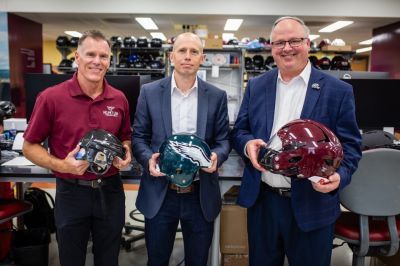The 2018 collapse of a pedestrian bridge in Miami, Florida, served as a headgear wake-up call for Scott Greenhaus. A 40-plus-year veteran of the construction industry, Greenhaus was working with his team to install a post-tensioning system when the bridge collapsed. It killed five motorists and one team member and left the job’s superintendent with a traumatic brain injury.
“When we got to the site, we noticed their hard hats were all lying on the ground where the structure came to rest,” said Greenhaus, co-founder of the advocacy group Hats to Helmets. “So we looked into it and said, ‘Wow, we’ve got to change the way we do business from here.’ ”Seven years later, Greenhaus believes the Virginia Tech Helmet Lab is providing key support to that change with the development of the first rating system for safety helmets.
Released on Sept. 22, the ratings are developed by analyzing information from falls in worksite environments and draw a sharp distinction between traditional “hard hats,” known as Type I helmets, and Type II helmets that include interior energy-absorbing materials. The results show that shifting to Type II helmets on average will reduce fall-related concussion risk by 34 percent and the risk of skull fracture by 65 percent, with the lab’s top-rated helmets showing risk reductions of 48 percent and 77 percent, respectively.
“Our findings show that choosing a Type II helmet can save lives,” said Steve Rowson, the lab’s director. “The difference in protection during a fall is dramatic.”
In 2023, 1 in 5 workplace deaths occurred in the construction industry, and across all industries, construction accounted for 47 percent of all fatal falls, slips, and trips, according to the U.S. Bureau of Labor Statistics.
Rowson, also a professor of biomedical engineering, said falls cause 60 percent of the industry’s traumatic brain injury fatalities and tests for the existing helmet standards, set by the American National Standards Institute, don’t accurately reflect the force of real-world falls. For instance, current hard hat standards only perform impacts at about a third of the energy that the Helmet Lab does in its tests that replicate jobsite falls.
Beginning in summer 2024, the Helmet Lab focused on “severe but survivable” job-site falls and worked to translate falls from 14 and 25 feet to laboratory tests to evaluate concussion and skull fracture risk. The research team – which included about 25 combined faculty, graduate students, and undergraduate students – then used the lab’s Summation of Tests for the Analysis of Risk (STAR) framework to combine data from multiple tests and compute an overall performance score for nine Type I and seven Type II helmets.
Image Courtesy of: Lee Friesland
“To have something independent [of industry ties] to discuss the science behind what’s being done with helmets, we really haven’t had that before,” said Greenhaus, now a senior advisor with the company Structural Group. “It will give us another arrow in our quiver to make the case for the transition to construction helmets.”
Safety helmets are now the 10th area for which the lab has developed helmet ratings, but it is the first non-sports helmet rating. Like Greenhaus, other industry safety advocates believe the system will empower leaders to more easily make equipment decisions.
“These ratings are incredibly important,” said Alex Kopp, director of environmental health and safety for the Association of Union Constructors. “Virginia Tech brings the research expertise necessary to evaluate helmets from multiple manufacturers objectively. Many contractors are weighing whether to switch helmet styles or brands — or whether a switch is needed at all. These independent ratings will give them the data they need to make informed choices that prioritize worker protection.”
This work has been propelled forward by a joint commitment of funding and guidance from the John R. Gentille Foundation, ELECTRI International, the American Society of Concrete Contractors, and the Association of Union Constructors.
As part of the collaboration, Rowson visited with a variety of groups and companies to speak about Virginia Tech’s research in this area and the basic differences between helmets.
Rowson spoke at the Safety and Health Conference for the Mechanical Contractors Association of America, Sheet Metal and Air Conditioning Contractors’ National Association, and Association of Union Constructors in January “to provide our members with an update on the study’s progress,” Kopp said. “Both Dr. [Barry] Miller and Dr. Rowson have been highly collaborative and transparent throughout this process, which we greatly appreciate.”
Along with the ratings, Rowson said it’s important that helmets fit properly and users wear the chin strap to keep helmets in place during a fall. He said the program will continue to update its ratings as new helmets are tested and developed by the industry and hopes to soon expand the testing to include data on helmet performance when struck by objects.
Greenhaus said he believes the rating system will have a ripple effect for individual companies and the industry as a whole.
“It will certainly, I think, lead to better quality helmets, which means safer helmets,” Greenhaus said. “And I think it will help people who are on the fence with their buying decisions. It’s difficult to make those buying decisions, and we don’t want them to just buy on price alone, because that’s not always the best solution”.
Feature Image Courtesy of: Peter Means
View the original article and our Inspiration here


Leave a Reply